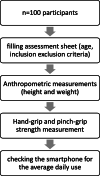The relationship between smartphone usage duration (using smartphone's ability to monitor screen time) with hand-grip and pinch-grip strength among young people: an observational study
- PMID: 33588812
- PMCID: PMC7885228
- DOI: 10.1186/s12891-021-04054-6
The relationship between smartphone usage duration (using smartphone's ability to monitor screen time) with hand-grip and pinch-grip strength among young people: an observational study
Abstract
Background: The use of smartphones has become widely popular, especially among young people, for multiple purposes other than communication, including gaming and internet browsing. The hand and wrist weakness is one of the main complications associated with the increased use of smartphones. This weakness occurs due to the repetitive flexion and extension of the wrist, thumb, and fingers, leading to a significant musculoskeletal pathology. Little is known about the relationship between smartphone usage duration (using the phones ability to monitor screen time) and hand-grip, pinch-grip strength. Therefore, the study was aimed to investigate the association between smartphone usage duration and hand-grip, pinch-grip strength among young people.
Methods: One hundred young males volunteered to participate in the study. Participants were briefly examined for height and weight using a portable stadiometer and a digital scale. Hand-grip, pinch-grip strength measurement was performed using a hand-held dynamometer. Smartphones usage duration was obtained from the daily average screen time reported in the last seven days.
Results: Mean daily usage of smartphone among the participants was 7.8 ± 2.2. There was a weak significant inverse relationship between smartphone usage duration and hand-grip strength (r=-.22, p = .03) and pinch-grip strength (r=-.28, p = .004). Linear regression revealed that 18.8 % of the variance in hand-grip strength and 20.4 % of the variance in pinch-grip strength was explained by age, and smartphone usage duration, with the addition of BMI only to hand-grip strength (p's < 0.00).
Conclusions: Prolonged use of smartphones was related to weaker hand-grip and pinch-grip. Despite the weak relationship, the study showed that smartphone usage duration might contribute as a factor along with age to hand muscles' strength.
Keywords: Hand functions; Hand-grip strength; Smartphones overuse; pinch-grip strength.
Conflict of interest statement
The author declares no conflict of interest.
Figures
Similar articles
-
Effect of Smartphone Usage on Neck Muscle Endurance, Hand Grip and Pinch Strength among Healthy College Students: A Cross-Sectional Study.Int J Environ Res Public Health. 2021 Jun 10;18(12):6290. doi: 10.3390/ijerph18126290. Int J Environ Res Public Health. 2021. PMID: 34200762 Free PMC article.
-
Effect of Smartphone on Hand Performance and Strength in the Healthy Population.Cureus. 2021 Jun 21;13(6):e15798. doi: 10.7759/cureus.15798. eCollection 2021 Jun. Cureus. 2021. PMID: 34306866 Free PMC article. Review.
-
Evaluating hand performance and strength in children with high rates of smartphone usage: an observational study.J Phys Ther Sci. 2020 Jan;32(1):65-71. doi: 10.1589/jpts.32.65. Epub 2020 Jan 22. J Phys Ther Sci. 2020. PMID: 32082032 Free PMC article.
-
Text neck is not associated with neck and upper limb disability in young adults who use smartphones.Eur Spine J. 2024 Mar;33(3):1187-1194. doi: 10.1007/s00586-024-08139-3. Epub 2024 Feb 18. Eur Spine J. 2024. PMID: 38369595
-
Strength measurements of the intrinsic hand muscles: a review of the development and evaluation of the Rotterdam intrinsic hand myometer.J Hand Ther. 2006 Oct-Dec;19(4):393-401; quiz 402. doi: 10.1197/j.jht.2006.07.024. J Hand Ther. 2006. PMID: 17056399 Review.
Cited by
-
The morphology of a smartphonopathic hand - smartphone use and the median nerve cross-sectional area.Pak J Med Sci. 2025 Jan;41(1):200-204. doi: 10.12669/pjms.41.1.9958. Pak J Med Sci. 2025. PMID: 39867807 Free PMC article.
-
Smartphones dependency risk analysis using machine-learning predictive models.Sci Rep. 2022 Dec 31;12(1):22649. doi: 10.1038/s41598-022-26336-2. Sci Rep. 2022. PMID: 36587033 Free PMC article.
-
Determination of hand grip strength and its correlates during pregnancy: a cross-sectional study.BMC Pregnancy Childbirth. 2021 Aug 4;21(1):540. doi: 10.1186/s12884-021-04003-0. BMC Pregnancy Childbirth. 2021. PMID: 34348682 Free PMC article.
-
Associations of sugar-sweetened beverage consumption and screen time with physical fitness index: a multicentre cross-sectional study among Chinese adolescents.BMC Public Health. 2024 Sep 28;24(1):2656. doi: 10.1186/s12889-024-20158-9. BMC Public Health. 2024. PMID: 39342150 Free PMC article.
-
Normative values for hand grip and pinch strength for 6 to 18 year-olds in Saudi Arabia.BMC Musculoskelet Disord. 2023 Feb 6;24(1):96. doi: 10.1186/s12891-023-06197-0. BMC Musculoskelet Disord. 2023. PMID: 36740670 Free PMC article.
References
-
- How Many People Have Smartphones in 2020?. Available from: smartphones#:~:text=Latest figures show an increasing,rate is at 45.4 %. Accessed 15 Oct 2020.
-
- Young adults quickly adopting smartphones in emerging economies. Available from: https://www.pewresearch.org/global/2019/02/05/in-emerging-economies-smar.... Accessed 19 Oct 2020.
-
- Wallace K. Half of teens think they’re addicted to their smartphones. CNN, Turn Broadcast. 2016;. https://edition.cnn.com/2016/05/03/health/teens-cell-phone-addiction-par.... Accessed 06 Nov 2020.
-
- Karlson AK, Bederson BB, Contreras-Vidal J. Understanding single-handed mobile device interaction. Handb Res user interface Des Eval Mob Technol. 2006;1:86–101.
Publication types
MeSH terms
LinkOut - more resources
Full Text Sources
Other Literature Sources




